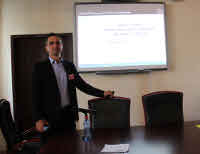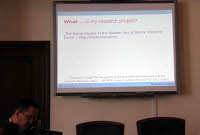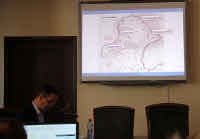“Salt vs. Limes” at the First International Congress on the Anthropology of Salt

The First International Congress on the Anthropology of Salt took place on the 20th – 24th August 2015 at Iași, Romania (http://ethnosalro.uaic.ro/salt2015/). The Congress was organised within "The ethno-archaeology of the salt springs and salt mountains from the extra-Carpathian areas of Romania" (CNCS UEFISCDI PN-II-ID-PCE-2011-3-0825) Project by the scientific board conducted by Marius Tiberiu Alexianu, from the „Al. I. Cuza” University of Iași.
The Congress reunited researchers of salt from 5 continents representing not less than 25 countries. The programme included sections such as „Anthropology and Archaeology”, „History”, „Halotheraphy”, „Heritage” and „Literary and Linguistic Approaches”. One of the days was dedicated to a special field trip, a visit of the Târgu Ocna Salt Mine (Bacău County), open both for tourists and economical exploitation. There the participants of the Congress were welcomed and accompanied through the whole visit by the Mayor of Târgu Ocna City, Mr. Ștefan Silochi.
Our project was represented by Alexandru Popa, who presented the work called "Salt vs. Limes in the eastern part of Roman Province of Dacia".
The presentation included the main issues regarding the relationships between the Roman Army in east of Dacia and Salt as a natural resource of this region.
We can often find in the specialised literature information about the richness in salt of Roman Dacia. Still, we notice that, as far as archaeological researches are concerned, the „Salt” of Roman Dacia is an issue that is mostly sustained by „logical indicators” rather than doubtless research sources. Modern research knows little or very fragmentary information or doubtless evidence such as salt deposits showing traces of exploitation in the Roman Period, tools, paleo-chemical traces of salt, clearly written testimonies regarding extraction, trade or traffic of salt.

 Based on existent epigraphic sources, recent research came up with the hypothesis of a rather „intermediated” implication of the Roman state in the activity of salt extractions. Accordingly, the activity of the Roman Salt mines in Dacia cannot be conceived without an intermediary chain of civilian „conductores”, who were either tenants - singular persons or associations of such persons. For example, Tsigarida says that the state’s control upon the salt resources was rather indirect and it only meant its minimal involvement in the economy of the salt mines (Tsigarida 2012). This conclusion creates the impression that this field of economic activity was possible to be carried out only as a purely “private” one.
Under these circumstances I have asked myself the question whether in a militarized Province, such as Dacia, the mechanism of salt extraction and (re)distribution could function without the direct implication of the Roman Army. In my opinion this must have been impossible.
Based on existent epigraphic sources, recent research came up with the hypothesis of a rather „intermediated” implication of the Roman state in the activity of salt extractions. Accordingly, the activity of the Roman Salt mines in Dacia cannot be conceived without an intermediary chain of civilian „conductores”, who were either tenants - singular persons or associations of such persons. For example, Tsigarida says that the state’s control upon the salt resources was rather indirect and it only meant its minimal involvement in the economy of the salt mines (Tsigarida 2012). This conclusion creates the impression that this field of economic activity was possible to be carried out only as a purely “private” one.
Under these circumstances I have asked myself the question whether in a militarized Province, such as Dacia, the mechanism of salt extraction and (re)distribution could function without the direct implication of the Roman Army. In my opinion this must have been impossible.
In his synthetic study regarding salt extraction in Roman Dacia, Volker Wollmann mentions a series of such localities, among which the following were in the eastern part of Dacia: Domneşti (BN), Jelna (BN), Sovata - Praid (HR), Sânpaul (HR) / Mărtiniş (HR), Ungra (BV). All these discovery points are found immediately next to Roman fortifications: Domnești – Jelna have in their vicinity the Roman Camp from Orheiul Bistriței, Sovata and Praid are found between the Roman Camps from Sărățeni and Inlăceni. The Salt mines from Sânpaul and Mărtiniș are close to the fortification from Sânpaul. Finally, near the supposedly salt mine from Ungra, we have the documented fortification from Hoghiz, Brașov County. In my opinion, all these fortifications were built consciously in the neighbourhood of rock salt deposits.
In the end of this research I can conclude that the Roman Army had an important role in organizing and developing the salt exploitation process in the eastern part of Roman Dacia. Dacia existed mostly due to strategic and military reasons. It was a strongly militarized Imperial Province, with an outstanding role of the military element in the life of the civilians. This statement also refers to the extraction and transportation of salt. It is obvious that in this activity many private entrepreneurs were involved, but the Army must have had control of their activity, as well as in assuring their protection.